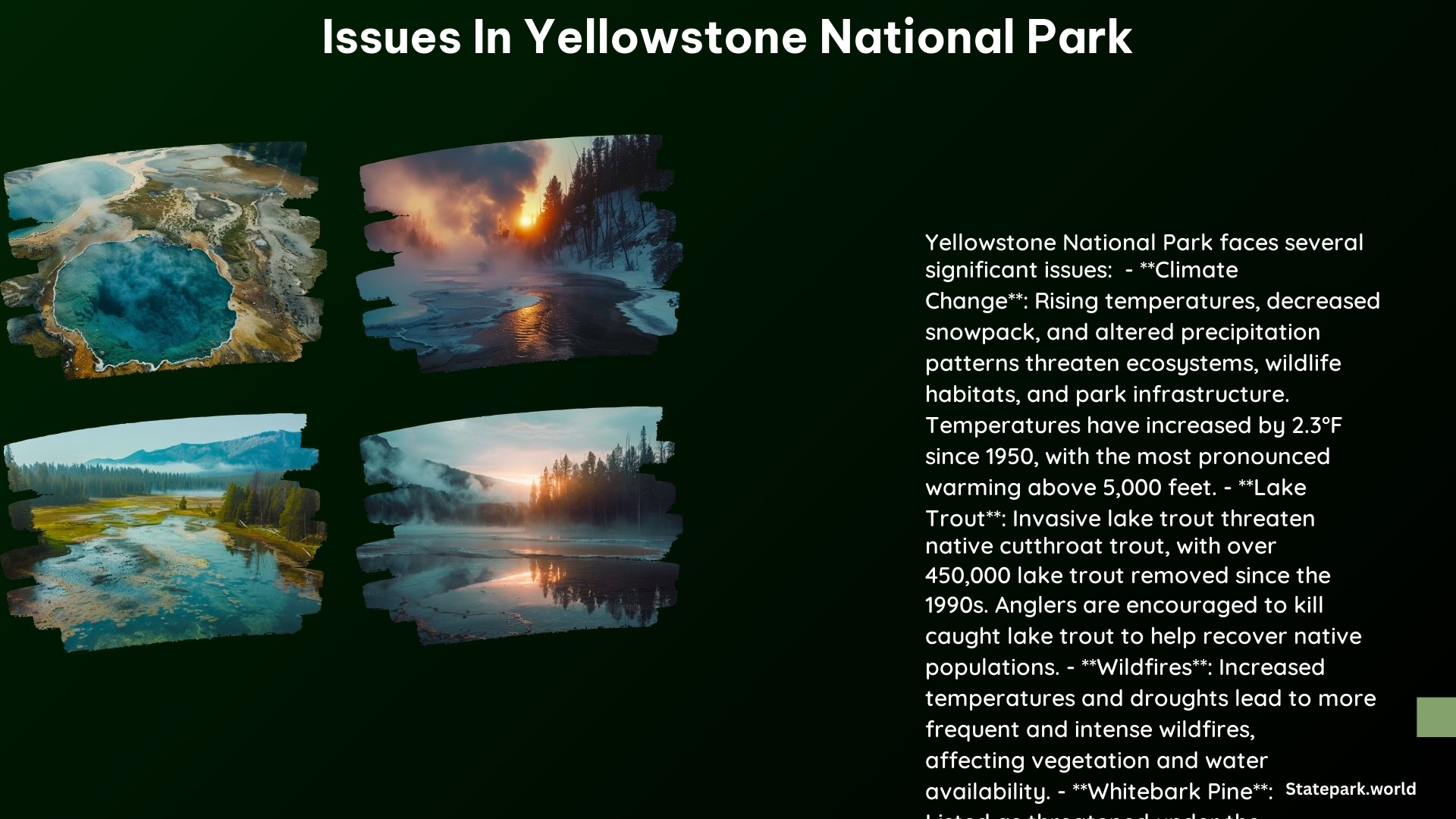Yellowstone National Park, the world’s first national park, faces a range of complex issues that challenge its natural and cultural resources, wildlife safety, and visitor experiences. From managing bear populations to addressing the impacts of climate change, the park’s stewards must navigate a delicate balance to ensure the preservation of this iconic American wilderness.
Wildlife Safety Issues
Bear Management
The park’s bear management program focuses on preventing bears from obtaining human food and garbage. Bear-proof food storage boxes have been installed in 72% of campsites, with a goal to complete the installation in all campsites by 2026. This effort aims to reduce bear-human conflicts and protect both visitors and the park’s bear populations.
Wildlife Habitat Disruption
Climate change is altering habitats, leading to the loss of essential habitats for species like the tiger salamander and whitebark pine. As temperatures rise and precipitation patterns change, the park’s ecosystems are facing unprecedented challenges, requiring ongoing research and adaptive management strategies.
Invasive Species
Lake trout, an invasive species, threatens native cutthroat trout. The park has implemented an intensive gill-netting program to reduce lake trout populations and protect the delicate balance of the park’s aquatic ecosystems.
Preservation of Cultural Resources

Cultural Resource Protection
The park’s preservation efforts include the rehabilitation of historic structures like Fort Yellowstone and the Old Faithful Historic District, ensuring compliance with the National Historic Preservation Act. These efforts help maintain the park’s rich cultural heritage and provide visitors with a deeper understanding of Yellowstone’s history.
Archeological Site Management
The park’s archeology program conducts site condition assessments and manages cultural resources to protect the park’s rich cultural heritage. This includes monitoring and preserving archeological sites, ensuring that the stories of the people who have inhabited the region for thousands of years are not lost.
Climate Change Impacts
Temperature Increase
Yellowstone has experienced an average temperature increase of 2.3°F since 1950, with the most pronounced warming at elevations above 5,000 feet. This temperature rise has far-reaching consequences for the park’s ecosystems and the species that call it home.
Changes in Snowfall and Runoff
Snowfall has declined, and peak annual stream runoff is now eight days earlier than in 1950. This alters the park’s hydrology and affects vegetation and wildlife, requiring the park’s managers to adapt their strategies to these changing conditions.
Increased Risk of Wildfires
Climate change is projected to increase the risk of wildfires, which can have devastating impacts on the park’s ecosystems. The park’s management team must be prepared to respond to these threats and mitigate the potential damage to the park’s natural and cultural resources.
Visitor Impacts and Management
Visitor Management
The park’s strategy focuses on mitigating visitor impacts on the ecosystem and cultural resources, ensuring a safe and enjoyable experience for visitors. This includes managing visitor flow, implementing educational programs, and enforcing regulations to protect the park’s delicate balance.
Infrastructure Management
The park must adapt to climate change by maintaining and repairing critical infrastructure, such as roads and facilities, affected by changing weather patterns. This requires ongoing investment and planning to ensure the park’s infrastructure can withstand the challenges posed by a changing climate.
Other Challenges
Lake Trout Management
The park continues to manage lake trout populations to protect native cutthroat trout, involving gill-netting and fishing regulations. This ongoing effort is crucial to maintaining the ecological balance of the park’s aquatic systems.
Bison Management
The park works with state and federal agencies to manage bison populations and prevent transmission to cattle. This collaborative approach helps to ensure the long-term viability of the park’s bison herds while addressing concerns about disease transmission.
These issues highlight the complex challenges facing Yellowstone National Park, requiring ongoing research, management, and conservation efforts to protect its unique natural and cultural resources. As the park’s stewards navigate these challenges, they must balance the needs of wildlife, cultural heritage, and the millions of visitors who come to experience the wonder of Yellowstone each year.
References:
– National Park Service. (2024). Resources and Issues – Yellowstone National Park. Retrieved from https://www.nps.gov/yell/learn/resources-and-issues.htm
– National Park Service. (2020). Climate Change – Yellowstone National Park. Retrieved from https://www.nps.gov/yell/learn/nature/climate-change.htm
– Yellowstone National Park. (n.d.). Yellowstone National Park Challenges. Retrieved from https://www.yellowstone.co/challenges.htm
– National Park Service. (n.d.). Strengthening the Yellowstone Ecosystem & Heritage Resources. Retrieved from https://www.nps.gov/yell/learn/management/strengthening-the-yellowstone-ecosystem-heritage-resources.htm
– Yale Environment 360. (2021). Yellowstone and Warming: An Iconic Park Faces Startling Changes. Retrieved from https://e360.yale.edu/features/yellowstone-and-warming-an-iconic-park-faces-major-change
